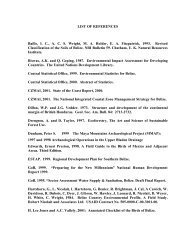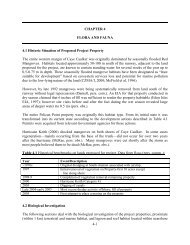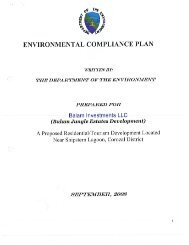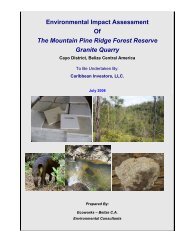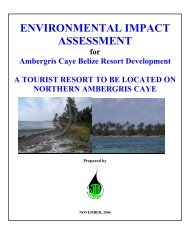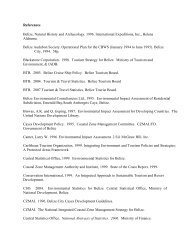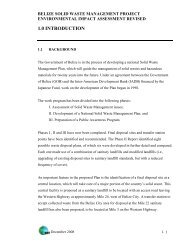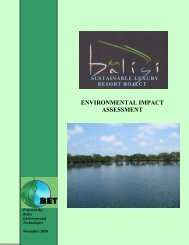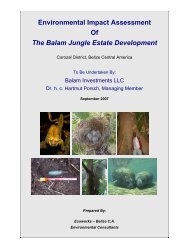Project Environment - Department of Environment
Project Environment - Department of Environment
Project Environment - Department of Environment
You also want an ePaper? Increase the reach of your titles
YUMPU automatically turns print PDFs into web optimized ePapers that Google loves.
2.5.2 Reserves<br />
Stretching five miles long and 1.2 miles wide, Caye Caulker has small but diverse habitats. Its<br />
northern end is completely covered in mangrove vegetation. In 1998, 40 hectares <strong>of</strong> this lush<br />
littoral forest on the northernmost tip <strong>of</strong> the island was acknowledged as the Caye Caulker Forest<br />
Reserve. Over 100 species <strong>of</strong> birds inhabit this lush ecosystem, including the Black catbird and<br />
Rujous-necked wood-rail.<br />
The Marine Reserve forms roughly the figure <strong>of</strong> a seven some 7 miles in length, with the top<br />
portion crossing the caye’s north point and extending into lagoon waters to the west. Area <strong>of</strong> the<br />
marine reserve is 96,661 acres. Today both are conjunctively known as the Caye Caulker Forest<br />
and Marine Reserve (CCFR/MR) (See Fig. 2.9).<br />
2.5.3 Land Uses<br />
There are no particular land uses <strong>of</strong> the area other than for the tourism industry. The caye itself is<br />
composed primarily <strong>of</strong> sand and is characterized by mangrove forests. As a result the tourism<br />
industry has had a major impact on the caye. On the whole, the construction <strong>of</strong> residential and<br />
commercial buildings along with the required infrastructure has left a major footprint on the<br />
island.<br />
2.6 Natural Hazards<br />
The only present natural hazard to affect the caye and in particular the proposed project site are<br />
hurricanes and flooding. The effects <strong>of</strong> major hurricanes over the years have changed the island's<br />
topography in certain areas. The Caribbean, in the last five years, has been severely affected by<br />
hurricanes resulting in substantial economic losses and social dislocation which affect the<br />
sustainability <strong>of</strong> development programs.<br />
Hurricanes have had the most devastating effect on Belize. Belizeans have experienced damage<br />
due to high winds and storm surges. Statistics gathered have shown that the coastal towns and in<br />
particular the cayes <strong>of</strong> Belize are extremely exposed. Flooding can manifests itself as a result <strong>of</strong><br />
the storm surges caused by hurricanes and by extreme high tides that are known to occur on the<br />
caye. Table 2.1 summarizes the potential hazards and its associated risks.<br />
Figure 2.6 shows, the projection and path <strong>of</strong> hurricane force winds along with the northerlies<br />
winds that dominate for some period over the project site. The hurricane winds are circular in<br />
motion and can last for a day or two. These winds generate strong to moderate waves that impact<br />
the coastline, especially on the western coast <strong>of</strong> the caye. The marina will be designed to sustain<br />
a minimal Category Three hurricane. Higher categories can cause catastrophic damages to the<br />
marina. For this reason it will be advisable for the occupants to take their vessel inland.<br />
2-16




